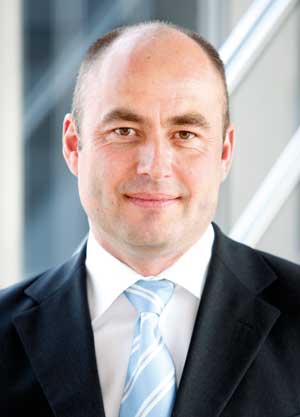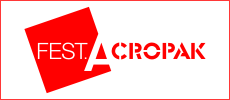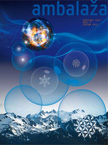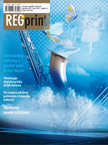«
Back to content
Vol 4 | Year 2013
B. Jablanowski - Keep Your Enthusiasm for Packaging!
Bernd Jablonowski, Director of Interpack & Save Food, Messe Düsseldorf GmbH, talks about Interpack 2014, a world - renowned trade fair for the packaging industry. He is confident that next year’s exhibition will be as successful as Interpack three years ago.
 The success of a trade fair largely depends on the level of satisfaction among exhibitors and visitors. This is why we emphasized in our 2011 final report that Interpack 2011 was one of the most successful ones. Nevertheless, I am confident that the conditions are in place for another successful Interpack to be held, says Mr. Jablonowski.
The success of a trade fair largely depends on the level of satisfaction among exhibitors and visitors. This is why we emphasized in our 2011 final report that Interpack 2011 was one of the most successful ones. Nevertheless, I am confident that the conditions are in place for another successful Interpack to be held, says Mr. Jablonowski. According to your slogan, Interpack is much more than a packaging show. As the world’s leading trade fair, it is the major inspiration of the packaging industry. What will be the focus of interest at the 2014 exhibition? What are the current key trends in the packaging industry?
Interpack is definitely the world’s largest and most important trade fair for the packaging industry and for the related processing industries. As such, it covers entire value chains and appeals to different target groups. These are, in particular, food, beverages, confectionery and bakery products, pharmaceuticals, cosmetics, consumer goods (non-food) and industrial goods. Each of these sectors has its own trends, on which it would be impossible to comment in any detail at this point. Nevertheless, despite all differences between the various sectors, we can see a number of general clearly recognizable trends that are highly relevant and indeed important to each of them. These are resource efficiency, safety and flexibility. Resource efficiency concerns, for instance, intelligent and innovative processes in packaging technology as well as the reduction of packaging materials. Another important point is to ensure consumer safety through packaging and through production and process engineering. Hygiene is of course essential in the food and beverage industries, but so is traceability, particularly for pharmaceuticals, as a vital way to maintain consumer safety. The third major trend is flexible equipment and processes, so that product suppliers – particularly in the food and beverage industries – can respond swiftly to changing consumer patterns and to increasingly shorter product life cycles.
You have announced that you are expecting 2,700 exhibitors from more than 60 countries who will present their latest ideas, innovative concepts and technological visions. Do you think this will be the biggest Interpack so far?
Like Interpack 2011, Interpack 2014 is fully booked again, so any difference in size will be marginal. I am confident that the conditions are in place for another successful Interpack to be held.
Trade fairs are a great opportunity not only to present innovative solutions, but also to make new direct contacts with potential partners. Do exhibitors find this fact interesting? Is there any information on how many contracts are concluded at fairs?
The only way to find out such figures – if at all – is through personal conversations during the trade fair, as they are not officially collected. But you already mentioned it: What matters at a trade fair such as Interpack is not direct contracts, but contacts – and this means maintaining existing ones and starting new ones. After all, it’s what makes the post-fair business successful.
Could you give us some technical information about next year’s show?
About 2,700 companies are coming as exhibitors, ranging from market leaders to niche players and they have approximately 174,000 square meters of net exhibition space available. It is always difficult to predict the exact number of visitors, but we expect more than 165,000 people.
In which segment of the packaging industry are you expecting to see the majority of exhibitors?
As a reflection of the market, the largest number of exhibitors will be those with products for the food industry, as this is where the largest amount of packaging is used. But the product range will also be enormous in the other target groups, mentioned in the beginning.
What sort of new equipment and machinery for packaging and processing will be presented at this year’s Interpack? In what way did the equipment presented at Interpack 2011 change the packaging industry?
I have already mentioned three major trends. In all three areas, quite a few new things will be demonstrated at Interpack. As these trends have been in the focus of the industry for several years now, Interpack 2014 can be expected to feature not only innovations, but further developments of the products shown in 2011 as well.
Sustainability is one of the major trends in packaging. Do producers who don’t run businesses under this principle have a chance to survive on the market?
In the long run, any company which is closed to this trend will undoubtedly have difficulties to remain on the market. Depending on the sector, this is more or less pre-programmed. The issue is of major significance for any products which are promoted directly to consumers, as consumers’ buying decisions are largely based on the aspect of sustainability.
Brand owners usually complain that packaging is a major cost item for them. Why are packaging costs so high?
I don’t want to present a detailed cost breakdown at this point. This is something each company needs to do for itself. Ultimately, packaging is often a specially tailored job for a specific product and therefore highly customized. But let me just say this: packaging not only has an important protective function for the content, but it is, above all, a highly effective marketing tool – particularly in a supermarket. This is something which branded goods companies need to bear in mind in their cost-benefit analysis.
Packaging is one of the key elements of brand development and brand recognition. Looking back at previous Interpack fairs, would you agree that each event has launched a dominant trend in packaging?
I do think that Interpack acts like a catalyst on such developments. The very fact that the relevant market players meet in one place is something that generates ideas for new trends and for the further development of existing ones. Personal dialogue and a broader perspective are undoubtedly essential, and Interpack provides ideal conditions for this purpose.
At Interpack 2011 the Packaging Innovationparc and the Metal Packaging Plaza attracted numerous visitors. Are you planning any similar events for next year?
Both special areas will be available again. The Innovationparc Packaging will be running under the motto Save Food in 2014. Exhibitors in this special area will be asked to present solutions to reduce food waste and losses. The Innovationparc Packaging will occupy 2,500 square meters in a high-quality marquee, situated between Halls 2 and 3. The Metal Packaging Plaza, which took place for the first time in 2011, will be held again in 2014, based on the same proven principles that were applied last time. About 40 exhibitors will demonstrate their metal packaging solutions. It is also the first time that tin plate manufacturers – ThyssenKrupp Rasselstein and ArcelorMittal – will exhibit products at the trade fair, acting through the Association of European Producers of Steel for Packaging (APEAL). The Metal Packaging Plaza will work in partnership with the German Association of Metal Packaging Manufacturers (VMV) and the European Metal Packaging Association (EMPAC). As well as the products and services of the exhibitors, there will be an information platform with a forum, bar lounge and various meeting points.
The Save Food Initiative, which was introduced at Interpack 2011, intends to contribute to the fight against food waste. How did Messe Düsseldorf become one of the founders, and how is the mission being implemented?
This goes back to 2010, when initial talks were held on the Save Food issue with the UN Food and Agriculture Organisation (FAO). We then set up this joint project which was subsequently presented at Interpack 2011. Interpack (and thus Messe Düsseldorf) makes a contribution through numerous international contacts with industry and associations which we want to include. It was therefore a logical step in early 2012 to turn Save Food into a corporate initiative which companies could join as sponsors. Since then the initiative has increased substantially and has reached the 100-member mark, representing the entire food value chain. Members include several big multinational groups such as Bosch, Maersk, Henkel and – as a recent newcomer – Nestlé. Early this year the Save Food initiative was joined by the United Nations Environment Programme (UNEP). So you can see that this area has developed enormously. As before, we are planning to hold a convention at Interpack 2014, on 7 and 8 May, bringing together experts from business, public life and politics for an exchange on food waste and losses.
What is your message to the Croatian packaging industry and to the packaging industry in this region or to be specific – to potential visitors from Croatia and the wider region?
I can certainly recommend to anyone with a professional interest in packaging and in the related process engineering industry to come to Interpack in Düsseldorf next May. It is a unique opportunity – and indeed the only one every three years – to gain a comprehensive overview of innovations in the industry and make international contacts. So it will certainly be worthwhile coming all the way from Croatia.
Interview by: Nataša Gajski Kovačić
















